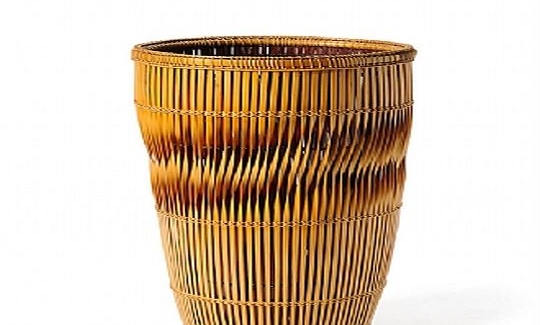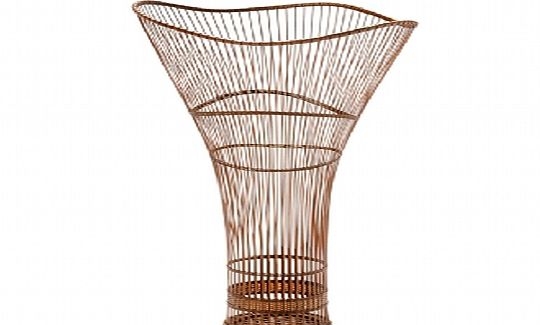Philip and Tomoko Rosenfeld have been collecting Japanese bamboo baskets for more than a decade. Their venture began with a casual visit to an antique shop in Japan. The owner described to them the complexities of creating a bamboo basket that had caught their eye. They were so fascinated that they began collecting these wonderful creations.
Japanese bamboo baskets are functional, charming and beautiful. Philip and Tomoko mainly collect those intended for ikebana (Japanese flower arrangement), an art in itself. Using the baskets has taught them to appreciate their beauty and the careful expertise required in making them. Japanese craftsmen invest great efforts in creating even the simplest bamboo baskets in order to adapt their design to that of refined arrangements of flowers.
The art of the bamboo (chiku kogei, take kogei, chikugei) is one of the most ancient crafts of Japan. It probably evolved because bamboo is so prevalent throughout the country, and due to its special qualities - its strength and excellent pliability for weaving. There are three main centres of bamboo basketry, populated by generations of craftsmen and their descendants: Kansai in the west, Kanto and Chobu in the east, and throughout Kyushu.
In the Shosoin at Nara, among the Japanese Imperial Collections, there are bamboo baskets from the Nara period (710-794) and of the Heian period (794-1185). The baskets were intended for flowers that were scattered during Buddhist ceremonies, and were made in basic basketry techniques which are still in use today.
After esoteric Buddhism reached Japan in the Kamakura era (1185-1333), and especially during the Muromachi era (1333-1573), bamboo baskets were imported into Japan from China (karamono). Their beauty aroused appreciation of this craft in Japan. From the end of the Muromachi era, until the beginning of the Momoya era (1573-1603), renowned tea-masters, among them Murata Juko (1423-1502), Takeno Joo (1502-1555), Sen no Rikyu (1522-1591) who developed the wabi aesthetic of the beauty of simplicity, of solitude and transience, and Hisada Sozen (1647-1707), aspired to expression of the unique Japanese aesthetic by means of bamboo baskets for flowers, charcoal, and other tea-ceremony implements, which they made themselves.
This continued during Edo era (1603-1868), and people also began to drink sencha - tea which is not ground to powder as it is for the traditional tea ceremony (macha). By the Meiji era (1868-1912) this had become customary. At the close of the Meiji era, in Osaka and in Kyoto, there developed a culture of Bunjin (aesthetes) influenced by the arts of China. These intelligentsia had a preference for bamboo artifacts, including baskets with handles, kikyoku chests for storing tea-ceremony articles, etc. In particular, they liked the free-form bamboo flower baskets with their innovative patterns.
The karamano style was particularly popular, and this encouraged an increasing number of bamboo craftsmen (kagoshi), so that the craft became extremely developed in Japan. The craftsmen continued to make simple, practical items for daily use according to the traditional techniques transmitted from father to son; but they also created highly aesthetic articles for the intellectual population.
Although Japan has a long history of basket-making, it was only at the end of the Meiji period that everything connected with the art of bamboo became rooted in the national awareness. The kagoshi, who were experts in basketry techniques aspiring to perfection and uniqueness, brought about the modernization of the craft during the Showa era (1926-1989).
Behind the interest in Chinese culture and style during the Meiji era was the popularity and spread of the tea ceremony in the sencha style. In Osaka, there were many kagoshi who catered to the refined taste of these "men of culture" and found patrons and sponsors among them. The originality of their works allowed them to be individual creators of artistic bamboo basketry. Hayakawa Shokosai I (1815-1897), his son Shokosai III (1864-1922), Wada Waichisai I (1851-1901) and his pupils Tanabe Chikuunsai I (1877-1937), Yamamoto Chikuryusai I, and Yamamoto Shoen (1864-1945), were known chiefly from exhibitions in Japan and abroad in which they participated.
Shokosai I was apparently the first bamboo artist to sign his works. His creations and others by his contemporaries were known as "bunjin baskets" because they were intended for intellectuals. Shokosai's creations - made in Osaka - are characterized by closely plaited bamboo with decorative insertions of rattan fibres (a type of tropical palm). They were mainly intended for the sencha ceremony. In 1877 he won a prize at the first exhibition to promote Japanese industry at Ueno Park in Tokyo, after which the work was purchased by the Empress. Shokosai I won other awards for his works integrating rattan in various techniques such as "chidori ami (plover plaiting), and "tatami ami" (tatami braiding). Even though he was largely influenced by the sencha and the karamono style, he succeeded in creating his own personal style.
Others considered as pioneers in the art of basketry include Wada Waichisai I, who won many prizes for his refined works, and his pupil Tanabe Chikuunsai I, both of them from Kansai. Chikuunsai also studied flower arrangement and the sencha tea ceremony. His deep understanding of those arts helped him to develop his craft. His own works comprise two main styles. That of Ryu Rikyo is in the finest tradition. Ryu Rikyo is the nickname of the bunjin-ga artist Yanagisawa Kien (1704-1758) who integrated baskets of flowers and fruit in his works. Chikuunsai dedicated himself to the study of baskets appearing in the works of Ryu Rikyo until he was ultimately able to create original flower baskets inspired by them. Ryu Rikyo baskets are boat-shaped, fan-shaped, or round, and some of them are intended for hanging. Most of them were created for specific exhibitions, and one actually received an award at the World Exhibition in Paris in 1925. Chikuunsai also wove ancient bamboo arrows into his baskets. The arrows have a dark patina with gold patches, and are sometimes lacquered in red or black. Chikuunsai did not split the bark into thin strips, but used broad patches in order to make the most of the beautiful colouring in his works. He was also versed in other techniques such as double honeycomb braiding (kikko niju-ami) and complex lozenge weaving (yotsume gaeshi), in which he integrated very fine open weaves. Occasionally he also integrated coarse bamboo, known as kinmaichiku and coarse braiding (ara-ami). Among his students were his son Chikuunsai II and Maeda Chikubosai I (1872-1950) of Osaka. Chikubosai exhibited his works in various exhibitions, after which most of them were presented to the royal family and the nobility. He emphasized the natural qualities of the bamboo, integrating the strange shapes that can be found in the bamboo stems and roots and selecting the rust-coloured elements.
During the Meiji and Taisho (1912-1926) eras and at the beginning of the Showa period (1926-1898), the basketry artists' creations were exhibited, mainly in the Tokyo area, confirming their standing as modern artists. An artist from the Kanto district whose creations differed from those of the traditional basket artists was Izuka Rokansai (1890-1958) who fought, almost single-handedly, for bamboo basket-making to be recognized as an art form. Later, he participated in important exhibitions at the renowned Institute of Trade and Industry, as well as in events devised by the Ministry of Education. After the Second World War he also exhibited his baskets in the prestigious exhibition of Japanese arts and crafts, the Nihon Dento Kogeiten.
Thus, new artists from the Kanto region, who appeared after Rokansai, traditional artists from Osaka such as Tanabe Chikuunsai I, Hayakawa Shokosai I and Maeda Chikobusai (1872-1950), and craftsmen such as Shuno Shounsai (1904-1974) of Oita Prefecture transformed the craft of bamboo basketry into an art.
Contemporary and traditional artists alike continue to create works that express their artistic preferences, developing their art and crossing the traditional boundaries, creating forms that echo the newest trends in contemporary art. In recent years, interest in bamboo basketry has extended beyond Japan. Solo exhibitions by artists such as Izuka Rokansai and Shuno Shounsai have been held, and the annual exhibition of "Living National Treasures" displayed the latest works of Tanabe Chikuunsai II. When the craft gallery of the National Museum of Modern Art opened in Tokyo in 1977, the art of bamboo basketry was gladly recognized, and the artists were classified according to the various schools.
In 1985 the Museum of Modern Art opened an exhibition called "Modern Bamboo Art". This was the first of its kind in Japan that presented an overview of the genre. It included works by Hayakawa Shokosai I and of avant-garde artists from the Meiji and Taisho eras, as well as works by Izuka Rokansai and other mainstream artists who "founded" the genre of modern bamboo art. There were works by contemporary Japanese craftsmen and designers together with classic items - karamono, and bamboo baskets created by revered tea-masters, including Sen no Rikyu. The exhibition shed light for Japanese collectors and others on the wonders of this craft. The Argentinian collector Guillermo Bierregaard even constructed a museum in 2006, in which he exhibits his collection. The first bamboo-ware exhibition in the United States presented the collection of Lloyd Cotsen at the Museum of Cultural History of the University of California in Los Angeles in 1988. Since then, the collection, comprising some 11,000 items, has been widely exhibited. Today it is held by the Museum of Asiatic Art in San Francisco.
It should be noted that exposure to the Japanese bamboo arts in the West began earlier in the mid-19th century, when Japanese bamboo baskets were on display at the International Exhibition in London and Paris. In 1933, the German architect Bruno Taut (1880-1938) visited Japan, and was very impressed by the baskets of Izuka Rokansai and Tanabe Chikuunsai II.
The aim of the bamboo artists of today, as in every other artistic genre, is to discover new modes of personal expression by means of interesting forms and techniques adapted to contemporary life. This exhibition is devoted to works by leading bamboo artists who have paved the way to acceptance of their art in modern times.
Philip and Tomoko Rosenfeld tell us that collecting Japanese bamboo baskets gives them great joy. They find them in different locales such as street markets, temples and handicraft shops as well as in antique shops. They say - "Our collection includes bamboo baskets that we bought in places all over Japan, and we love coming home with each new acquisition. We hope that you too will enjoy them as much as we do."



